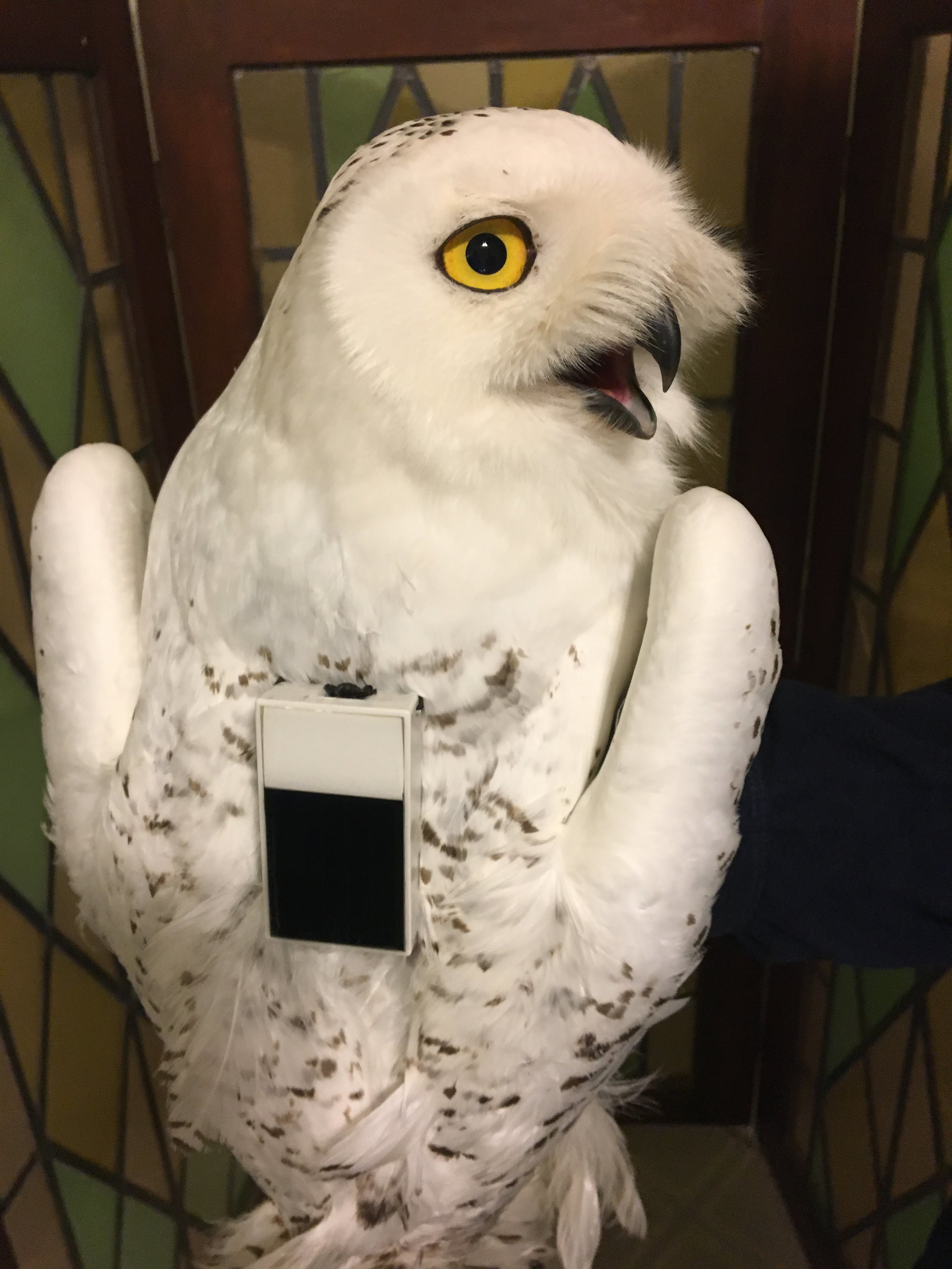The intense gaze of Arlington will be remembered by those who worked with and tracked Arlington as he wintered near Goose Pond Sanctuary in 2018. Photo by David Rihn
In January 2018, a snowy owl near Arlington, WI was outfitted with a GPS transmitter and tracked by hundreds of scientists and community members. In April, he was found dead in Benton County, Minnesota. The story of “Arlington”, the snowy owl, is one of science, conservation, and community.
Snowy owls hatch and spend their summers and fall in the tundra of northern Canada, and migrate south in early winter, especially in years of high lemming populations when many young are raised. One particular snowy owl was six months old in December when he stopped to spend the winter near Madison Audubon Society’s Goose Pond Sanctuary and the UW Arlington Agricultural Research Station, 17 miles north of Madison. He was one of thousands of snowy owls that flooded into the northern United States and southern Canada during this snowy owl “irruption year”.
Staff and volunteers with Madison Audubon Society, a local non-profit organization that works on bird conservation, seized the opportunity to study one of the five snowy owls in the local area. On January 4, 2018 master bird bander Gene Jacobs and MAS staff and volunteers caught two young male snowy owls at the UW Research Station. Both owls were banded and after taking detailed measurements, the larger owl was outfitted with an ultra-light transmitter that allowed Project SNOWstorm, a national non-profit that studies snowy owl winter ecology, and the public to track the whereabouts of the owl. He was lovingly named “Arlington”.
Arlington was outfitted with a GPS transmitter on January 4. The ultra-light backpack was recovered after Arlington was likely struck by a vehicle in central Minnesota. These transmitters are shown to have no impact on the birds' ability to lead normal lives. MAS Photo
“It was an incredible experience,” say Mark Martin, resident co-manager of Goose Pond Sanctuary. “The rollercoaster that led up to his banding, the intense thrill of working with a snowy owl, and the prospect that we would be able to track how he used the Wisconsin landscape in winter and into the future will live in my memory for a long time.”
Arlington showed interesting behaviors over the winter, such as significant side trips to Lake Koshkonong in Jefferson County and Puckway and Rush Lakes in Green Lake County. Each time, he returned to the area where he was caught and banded. Project scientists, MAS members, UW Agricultural Research Station staff, and the public followed his movements on an online map that provided over 2,700 hourly locations.
Arlington was in the local area until March 2, when he began what should have been his 1,500 mile migration back to the tundra. He visited Puckaway Lake again, then Pentenwell Flowage, Alma Center, and stopped in northwest of the Twin Cities in Cambridge, Minnesota, where he spent most of April in an industrial park and nearby residential area. He then headed northwest to Benton County, where his journey ended after he was likely struck by a passing vehicle on a county road on April 29, 2018.
April 2018 was one of the coldest and snowiest Aprils on record for the upper Midwest. Deep snow and north winds kept Arlington grounded in Minnesota when in a normal year he would have been far north by the end of April.
“We were fortunate to have Arlington in our lives,” said Susan Foote-Martin, resident co-manager at Goose Pond Sanctuary. Arlington will be missed by his Madison Audubon family, followers at the UW Arlington Agricultural Research Station, local residents, and Project SNOWstorm volunteers, and followers. “Photographers and youngsters in particular have really enjoyed learning about snowy owls and seeing him this winter,” Sue shares. “We are saddened by his loss, but hopefully we will have the opportunity to work with another wintering snowy owl this coming winter.
Project SNOWstorm will continue to collect data on 20-25 owls outfitted with transmitters. Scott Weidensaul, with Project SNOWstorm, wrote, “We’d like to again extend our thanks to Madison Audubon for sponsoring Arlington’s transmitter — this is a hard loss for them as well as us, but Arlington’s movement data is and will remain a valuable legacy.”
For more information about Madison Audubon’s adventures with Arlington, visit madisonaudubon.org/arlington.





